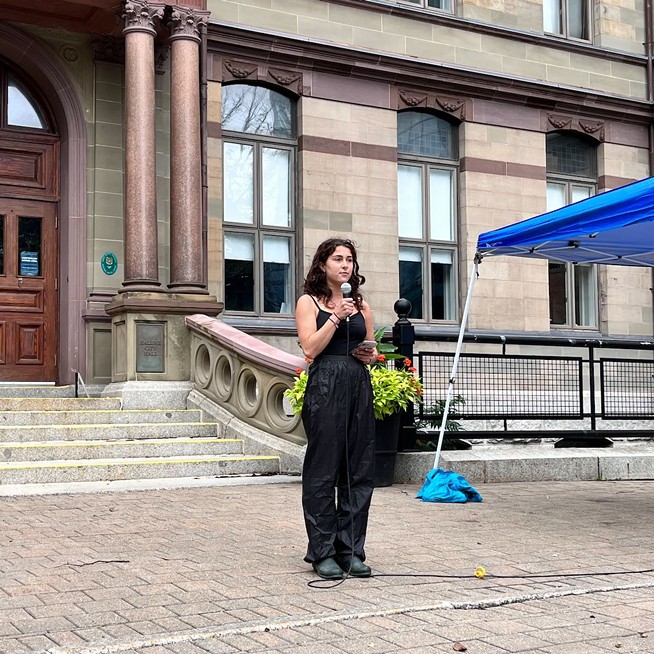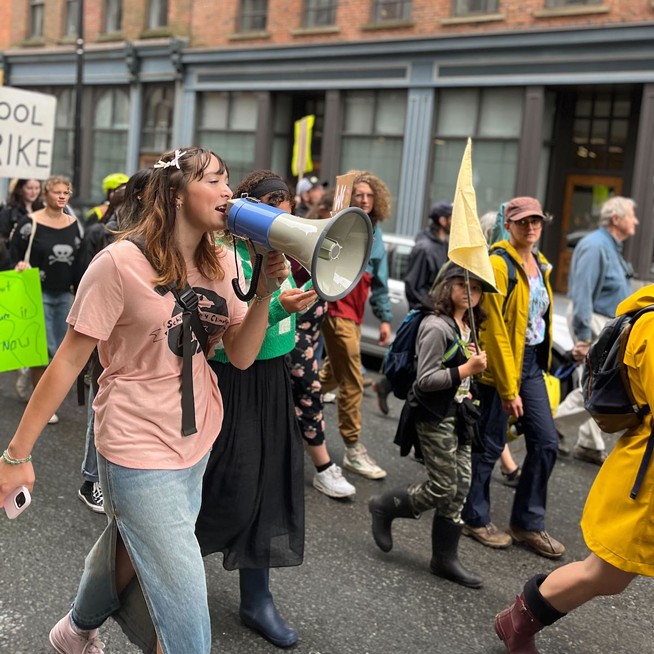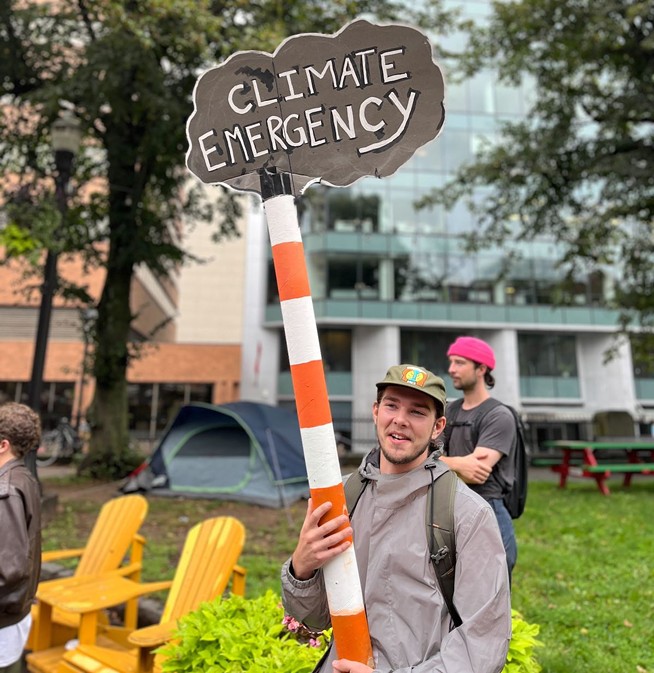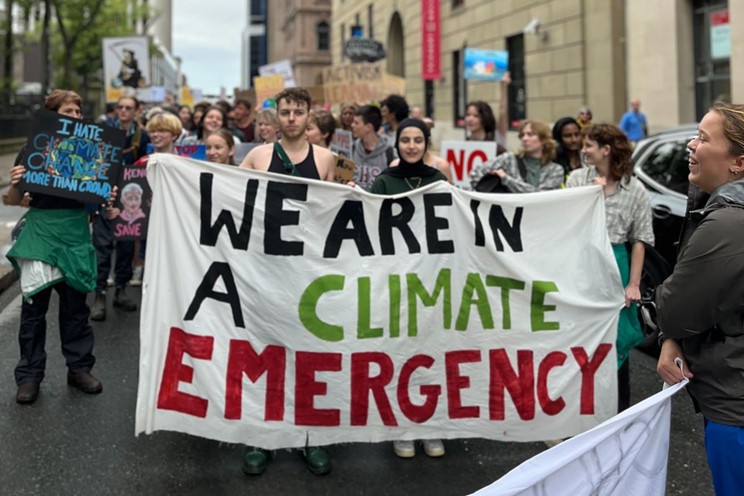Jane Elliott stands poised with her back to the red stone tower of Halifax City Hall. She’s dressed in a sleeveless top and rain pants. Ready for heat. Ready for rain.
The northern face of the seven-story tower faces out towards Grand Parade, dotted with tents wet with the morning’s rain. The clock on the tower is stopped at four minutes past nine, to mourn the Halifax Explosion of 1917, although it’s closer to 1pm.
Elliott holds the eyes of hundreds, nearly all of them hoisting signs demanding action on climate change from the municipal government employees who fill the offices behind her.
This Friday afternoon climate protest is the fifth year she has organized with School Strike 4 Climate Halifax—a branch of the international youth-led movement demanding immediate and sustained policy action on climate change and ensuring climate justice for all. This means ending environmental racism—a byproduct of colonialism that disproportionately harms marginalized and low-income communities through heightened exposure to environmental risks, such as lack of access to clean drinking water and proximity to pollutants.
Elliott is in high school. At the time of her first student climate strike, she was 13 years old. "It's difficult to describe how I feel about that anniversary,” she says. “The uncomfortable truth is: I'm not sure it actually matters. I've oscillated between hope, anxiety, anger and exhaustion, and yet the urgency to act remains the same.
“Talks of wildfire and climate disasters, which seemed abstract to me at 13, have become very close to home. I am no longer asking my friends if they've heard about faraway wildfires—I'm asking if they need a place to stay because they've been evacuated from their home. Navigating climate disasters has become a regular part of organizing these strikes.”

Hurricane Fiona caused the organizers of last year’s strike to cancel the annual event, and Hurricane Lee is moving towards Nova Scotia as Elliott speaks, forecast to make landfall tomorrow. This year’s slogan has incorporated that near-recurring and ironic reality. Despite the weather, despite climate fatigue and anxiety, “We’re Still Striking!”
Students of all ages, as well as older allies, flank Elliott as she speaks. In the stony city-commons, solidarity with the empowered and impassioned youth leaders of School Strike 4 Climate Halifax is overwhelming. The “We” of the We’re Still Striking message is proof of resilience, leadership and even hope among younger generations that have inherited a climate forever changed.
But Elliot continues. “The future could still be bright. A plan to navigate our changing climate must include affordable education, affordable food, affordable housing and better public transportation.
“That's why I'm back here, and I will continue to come back and demand better until our government respects and protects its people more than its profits. We have undeniable strength in our numbers. So let's stay loud!"
Elliott is one of several student organizers with School Strike 4 Climate who have grown up walking out of school once a year on a Friday in September. Elliot’s cohort is now “aging out” as they finish high school, with many leaving the city to pursue university degrees elsewhere. They'll be using the next nine months to recruit, empower and train new youth-leaders to continue to stay loud.

As the strike begins its parade route down Hollis Street, colourful signs raised high above the masses, chants of “Climate change is not a lie, please don’t let our planet die,” and “We are unstoppable! Another world is possible” ricochet off the downtown buildings.
The strike fills Hollis Street, going past the provincial legislature and then on to the doorstop of Nova Scotia Power’s headquarters, before heading up Morris Street and returning along Barrington to, again, complete a semi-circle of activists in front of of City Hall and allow other student leaders to speak.
Rae Steeves, a student organizer who plans to move to Ottawa next fall for school, was 12 when she started her journey as a climate activist. “I started speaking because I was angry,” Steeves says. “Angry that I was 12 and felt the need to grow up overnight.
“I was 12 and taught myself to write press releases, to deliver speeches, what to say when someone asked me why I'm doing what I'm doing other than the obvious answer, which is: 'Adults aren't, so, who else?'
“I was 12 and already felt betrayed by the people in power I was supposed to trust.
“I was 12 when I was putting off my homework to read climate bills. I was angry, frustrated. But mainly I was scared. Horrified. Young people are dismissed, ignored and pushed to the side. But the youth are watching and listening and we're angry.”
Steeves, who is now 17, says she feels no different than when she started.
“I'm still angry, frustrated and feel betrayed by the people in power I'm supposed to trust. But I'm also very hopeful,” she says. “I've seen change happen. I've seen what good we can do when we all come together like this. The youth have been here on the front lines. We haven't disappeared, and we will not until genuine climate justice is achieved.”
The office of the minister of environment contacted organizers of School Strike 4 Climate Halifax to set up a meeting with minister Timothy Halman in the near future. Whether that materializes or not, Steeves has a message for provincial leaders.
“I want them to know how scared people are. Not only the youth, but just everyone in Nova Scotia. We had unprecedented weather this year, from the hurricanes and the fires and the floods. And I think that scares a lot of people. And I also want them to know, when I started out I was 12, and a lot of people were that age.
“We're almost voting age now. And I think sometimes the issues that youth care about are swept under the rug, because we're not voting age. So I think it's important for them to realize that we are going to be voting age soon. And if they don't take the concrete action that we're asking for, then they may not get reelected.”
Steeves and School Strike 4 Climate have also pushed for primary and secondary schools to incorporate climate change into their curriculums, and they’ve succeeded.
“We've been meeting with the minister of education and I'm grateful that they listened to us, but they haven't proven themselves worthy of our trust yet,” says Steeves. “I'm not really going to praise it until it actually happens.”
Education on climate change is a necessary, if troubling, reality for students of all ages. Supporting students who feel climate anxiety alongside the regular duties and responsibilities of growing up—that is also a necessary truth.
“We should listen to the youth because we shouldn't be doing this,” says Steeves. “We're young, we should be having a normal childhood. But we feel as if we're forced to and I think that it's really important for adults to realize that we're not striking because we just like to protest.
“We're striking because we feel betrayed. And I really want them to understand that and to take action on a systemic level, especially. Write letters to your politicians. Vote with the climate in mind.”
Sadie Quinn, a University of King’s College student and organizer with School Strike 4 Climate, aptly draws the line between the strike, the austere and quiet facade of City Hall and the encampment of tents for underhoused Haligonians.
“Respect the tents that are currently set up around City Hall,” says Quinn. “This is a stark reminder of the housing crisis we're experiencing right now. And I hope that those who work at City Hall will see the tents every day and are motivated to take action beyond that. Climate justice includes safe housing for all, and I hope we can all remember that today.”
Quinn has experienced climate anxieties, too, through secondary and post-secondary life. “Even the uncertainty around last year's strike and this strike, like 'Can it even happen? Will my house lose power this weekend?' There's things like that where it's always uncertain about our lives being disrupted. And I think that's always going to become more frequent.”
Despite this frequency, fellow strike organizer Iman Mannathukkaren’s speech enlivens the crowd. “We cannot lose hope now,” she says. “It's true that this feeling of fatigue has been following me around as I read the news or think about the future. But one thing I'm not tired of is striking.
“I'm not tired of fighting back. In fact, the act of resistance is how I combat the fatigue that I do feel. I'm the product of a time where so many things have gone wrong, it can be easy to feel jaded as a default. But I'm also a product of a time where people have come together to resist and move forward in a better way.”

There’s strength in numbers, and that feeling echoed off the stone facade of municipal government on a day that miraculously held off the rain.
There’s strength in connecting across decades with other youth-led environmental movements, too. As Joanna Bull, the community engagement manager with the Ecology Action Centre in Halifax, noted, “The Ecology Action Center itself was founded by a group of students more than 50 years ago.
“We really understand the way that young people's leadership has a really important role to play in social movements generally, and in the environmental movement right now. They've been taking so much leadership, and we're here organizing with them, shoulder to shoulder.”
Bull was here with Elliott, Steeves, and the other student organizers five years ago when over 10,000 people filled the streets of Halifax demanding leaders to act now to address climate change.
“The following week, that provincial government put out the most ambitious climate plan that they had ever done, and was actually the most ambitious in the country at the time. Historically, that tends to be what makes a difference to governments, if they see that that's what the voters prioritize.”
Now, prioritizing climate justice is developing at a very young age and, hopefully, says Bull, teachers are supportive of that.
“The purpose of school should be to equip young people for the world that they're going to be living in. And if we pretend that that world is one where the climate is not totally disrupted, we are not preparing them for their future.” Bull says the role of school should also empower students to use their voices to shape the world. “Because we're going to need to keep doing that.”
Terra Carter is a member of the University of King’s College Students’ Union, the KSU, and tells the crowd that climate change is “making it unbearable for all of us to live.” The union calls on the provincial Department of Advanced Education to fund long-overdue solutions to campus housing that overheats in the first weeks of school—to the detriment of first-year students paying some of the highest tuition prices in the country.
Terra Carter, another KSU member, also has a message for the advanced education department: “Fighting for climate justice means many things and one of those is fighting for education, because if we are not educated we do not know what to do. And if where we are trying to be educated is ‘slow roasting’ us—[the department’s] words, not mine—then it is not a place where we can be suitably educated. If the provincial government cares about getting students in here, they'll lower tuition, they'll fund universities. They'll do stuff that benefits the students!"
Carter echoes sentiments expressed by other organizers of the mobilizing effects of anger and fear. “Us students, we are standing here bound together by a rage to fix this world because the people in power have failed to do so for generations,” they says. “And now it is our responsibility because they have failed.
“We have elected them into office. They are our employees... it's about time they started acting like it."
Quinn has a message for environment minister Halman, who is himself a former teacher. “We are still watching. The policies, especially the Nova Scotia Climate Change plan that was released last year, which is so comprehensive, we want to see those policies implemented and funded in the budget.
“When budget time comes around, that's something we'll be watching for. And we might be pressing him on certain details, or on certain aspects of the plan that lack detail.”
Her reluctance to praise too quickly, like Steeves, comes from seeing the inconsistencies between talk and action leaders. Quinn’s thoughts on the province’s climate plan?
“I have a hard time believing that certain aspects of the economy and society will be able to shift in time [to zero emissions by 2050]. There was talk of natural gas extraction and gold mining, even in this climate plan, which doesn't really feel like it should be in there.
“I hope we see less of that, and more transitioning to clean energy while keeping people's jobs in mind. We will continue to make noise as you continue to not act fast enough on climate change. We need urgent, sustained and justice-centered climate action, and we can't afford to stall any longer.”


